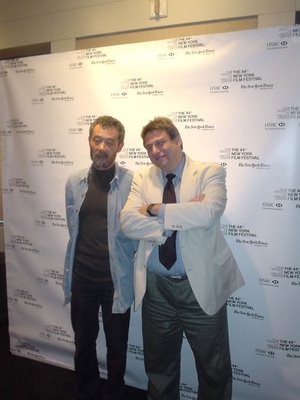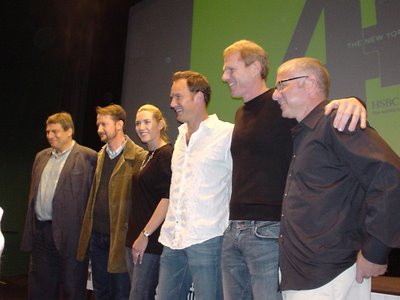The Queen press conference at the 44th New York Film Festival
 Photo by Martin Tsai. The Queen director Stephen Frears outside the Walter Reade Theater in New York City on Sept. 25.
Photo by Martin Tsai. The Queen director Stephen Frears outside the Walter Reade Theater in New York City on Sept. 25.
 Photo by Martin Tsai. Film Society of Lincoln Center program director Richard Peña, The Queen star James Cromwell, director Stephen Frears, star Helen Mirren, writer Peter Morgan and producer Andy Harries at the Walter Reade Theater in New York City on Sept. 25.
Photo by Martin Tsai. Film Society of Lincoln Center program director Richard Peña, The Queen star James Cromwell, director Stephen Frears, star Helen Mirren, writer Peter Morgan and producer Andy Harries at the Walter Reade Theater in New York City on Sept. 25.
By Martin Tsai
“If you are British, the royal family is very complicated and they are laughed at nonstop. They are in many respects quite ridiculous. On the other hand, you can’t make the film from many positions that don’t contain sympathy for or curiosity about the sort of human beings underneath it all,” director Stephen Frears said. “What’s shocking and controversial about this film is that it takes them seriously.”
Frears’ new film The Queen, which just opened the 44th New York Film Festival, focuses on how the British royal family coped in the aftermath of Princess Diana’s death and the relationship between Queen Elizabeth II and British Prime Minister Tony Blair at the height of his popularity. Though much of the film draws from actual events, screenwriter Peter Morgan imagines the goings on behind the scenes.
“The relationship between the queen and the prime minister has always been the thing that sort of piqued the interest for me,” Morgan said. “The fact that they are in a room together and the fact of them talking about politics or all these meaningless conversations, it immediately has constitutional resonance for me as an Englishman – the idea of putting that kind of power in the same room and the sort of private audience they might have.”
The events depicted here took place nearly a decade ago, and the British public’s opinion of Tony Blair has changed considerably. Although depicting him mostly as a sympathetic character, Morgan illustrates the “conservatizing of Tony Blair.”
“We couldn’t do a hatchet job on him if we wanted to because this was sort of his finest hour,” Morgan said. “For the film to portray him badly would just be irresponsible and inaccurate. He conducted himself extraordinarily well. Having said that, we did look for opportunities to try and express some of that.”
In preparation for the title role, actress Helen Mirren said she read a lot, looked at portraits, watched videos and was lucky to have a wonderful voice coach. “I was very drawn to the queen as a young girl, and spent most of my time researching and watching things from when she was young, before she ever had any slight ideas that she would be the queen. I thought that would probably reveal the true character and her true personality.”
Frears said that his empathy for the queen has probably deepened because of Mirren’s performance in the title role.
Mirren allowed, “Actually, I’m not really a very political person. I think a lot about politics, but I don’t mix with politics. I was happy about Labor coming into power, because it was a change and the change was very much needed at that time in Britain. It was exciting and interesting to view what might be coming next. But I am very cynical about politicians, all of them. I am holding out no great hopes for utopia or a new day in Britain. But in terms of it playing into my occupation, I think more of my feelings toward monarchy play into that. I grew up in a vehemently anti-monarchy family, and I embraced these ideas and frowned on the royal family for a very long time – until relatively recently when I’ve mellowed somewhat."
© Copyright 2006 Martin Tsai. All rights reserved.










